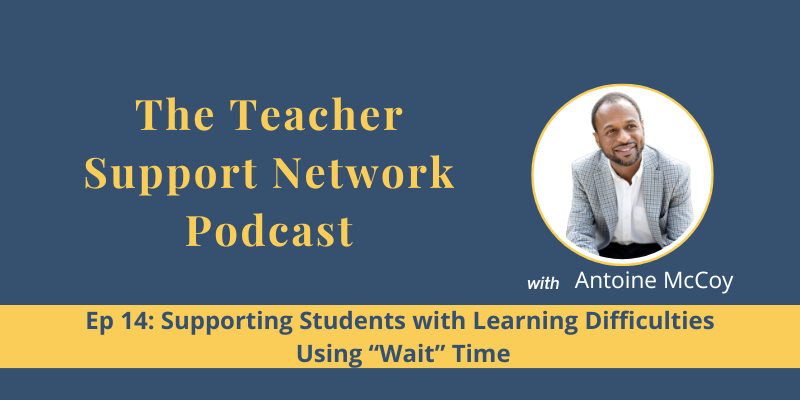
In this episode ~
In this episode of the Teacher Support Network podcast, we explore the power of wait time, a strategy that benefits all students, particularly students with learning disabilities and learning difficulties.
The episode will look deeper into the benefits of allowing student “wait” time and provide practical tips for implementing “wait” time more efficiently and effectively in the classroom.
Download the Gen Ed and SPED Teacher Collaborative Conversations Guide in the resource section below to help support you in fostering intentional conversations with your fellow teacher colleagues.
Listen in~
00:31 Understanding Wait Time in the Classroom
01:22 The Benefits of Implementing Wait Time
04:35 Strategies for Effective Wait Time
06:03 Practical Classroom Examples
07:46 Conclusion and Call to Action
Useful Resources:
Download Gen Ed & SpEd Teachers Collaborative Conversations Guide here.
Join my Newsletter for a weekly dose of practical strategies, tips, resources and inspiration to support you on your teaching journey here.
Transcript
Hey Teachers ! Welcome to the Teacher Support Network podcast. I'm your host, Antoine McCoy, and today we're diving into the power of “wait” time, a simple but game changing strategy that can make a world of difference in student participation in your class, especially for those with learning disabilities.
So have you ever asked a question in class and been met with silence? Well stick around because that pause might be more powerful than you think. Exactly what is “wait” time. Well, it's that intentional pause after asking a question, giving students a few extra seconds to think before responding.
Research shows that giving students wait time can significantly improve class discussions and student confidence. Too often as teachers, we expect immediate answers. And there's a time and place for that. But some students, especially those with learning disabilities, need extra time to process before speaking.
Imagine asking a student what's 12 x 8 ? Some students might blurt out the answer instantly, but others are still calculating the problem in their mind. So without wait time, those students might never get a chance to really participate in the class.
So, let's talk about why giving students wait time works.
Well first, allowing wait time gives students valuable processing time. Many students, especially those with learning disabilities, need extra time to understand the question and organize their thoughts before they answer a question. Students with learning disabilities often process information slower than usual, but it doesn't mean that they don't understand what is going on either. Many times they never participate in class because they know that someone else will answer or the teacher will not give them adequate time to answer and just call on another student.
Second, allowing wait time helps to reduce anxiety. No one likes feeling pressured to answer questions quickly, especially if they're unsure about the answer. A student may be fully aware of what is going on in class, but the pressure to respond on the spot may bring a level of anxiety and fear to the surface that paralyzes them so they don't respond or say anything at all. So sometimes if you get that deer in the headlights look when you call on a student, that's kind of the response that can happen when they’re gripped with anxiety because they don't want to answer. This response is especially bound to happen if it's a challenging academic area for the student.
Let's look at ourselves as educators. How many of us like to be put on the spot by an administrator at a faculty meeting or have you ever been to a professional development conference and a presenter calls on you in front of your peers? Unless that's the nature of your personality, and you don't mind being called on like that and put on a spot, the answer's probably no, that you usually don't like that, and you'd rather have some time to consider or think about your answer before you do it.
Third, allowing wait time encourages deeper thinking from students. So instead of rushing to answer, students can really craft a more thoughtful response to a question that you may ask or an activity you may give them to do.
Fourth, allowing for wait time really kind of promotes greater inclusivity in the classroom. You know, on this podcast we talk a lot about creating inclusive classrooms and when you allow wait time you give everyone time to answer questions and participate in class discussions. You're not just hearing from the student who answers the fastest or who raises their hands the fastest and just calls out. It actually helps to even the academic playing field and that really brings a more inclusive classroom environment for all your students.
Finally, and perhaps most importantly, allowing wait time builds confidence in your students, especially those who have learning difficulties. When students feel prepared, they're much more likely to raise their hands and positively contribute to the classroom discussion and to whatever is going on in the classroom in general.
All right, so how can teachers make wait time more efficiently done in the classroom? Here are a few strategies for you to consider about implementing wait time in a classroom. First, when you ask a question, try silently counting to five before you call on someone. See, I just waited and counted in my head around five seconds, and it might feel like a long pause, but in the classroom it can be very effective in getting students to participate.
Second, consider allowing students to write down their answers before sharing. This way, there's a pause before having to answer, and it may encourage more thoughtful answers and give students a greater chance of actually coming up with an answer and sharing it with the class.
Third, make “wait” time a classroom norm. It's just something that you do in your class or something I do in my class. This lets students know that thinking before answering is okay, and not only is it okay, but it's encouraged, so they don't have to feel the pressure to always do that and feel the pressure to always have to answer right away.
Last but not least, I want to close with this strategy that I used in my classroom of my students with learning disabilities who I knew from the IEP and formal testing that they processed information slowly. Knowing this information beforehand with certain students in my class, I might say something like this.
So let's say I'm in a math class and I wanted to have students give me the answer to problems on a math worksheet. Let's say it's a multiplication worksheet. If I knew there was a student who didn't participate a lot and was a slower processor, I might tell the student.
“I want you to be ready to give me the answer to question number five on the worksheet, five times four, and I'm going to call on some of your classmates to answer questions # 1-4 before I call on you.”
Now this doesn't guarantee a response or even a correct response from the student, but at least it gives them time to focus on their specific problem before having to answer. It won't come to them as a surprise,and that would help hopefully to reduce any potential anxiety they may have. Also, they can be included in the classroom discussion through participating.
So it's a little small shift, but just having that forewarning that they're going to be called on for a particular problem, but giving them the time to do it, increases the chance of them participating and being successful in giving their responses to the class.
So to wrap it up, wait time is a simple but incredibly powerful strategy that can transform classroom discussions and encourage greater participation from your students, especially those with learning disabilities, learning difficulties or learning challenges. It helps students process information, reduces anxiety, and makes class participation in general more inclusive.
So if you're a teacher and you don't use wait time enough with your students, I challenge you to try it out this week. Pause for a few extra seconds after asking a question and see what happens.
Have you used wait time in your classroom and with your students? If so, how's it working out with getting students to actually be part of the classroom environment and to participate more?
Let me know your thoughts in the comments section on our show notes page for this episode. Also, connect with me on social media at The Teacher Support Network on Facebook or teacher Support Network on Instagram.
Finally, if you enjoyed this episode, please share it with fellow teachers and check out our resources on the show notes page for this episode as well.
That's it for now. Until the next episode, make it a fabulous week. Bye now.
Rate, Review, & Subscribe on Apple Podcasts
Enjoy this episode?
Please consider rating and reviewing the podcast! Your support helps me support more teachers - just like you - create inclusive classrooms, foster effective teacher collaboration, and find balance with the demands of teaching in and outside of the classroom
It's easy! Click here, scroll to the bottom, tap to rate with five stars, and select "Write a Review." I'd love to know what was the most helpful or encouraging about the episode!
While you're there, you can subscribe to the podcast if you haven't already. If you're not subscribed, you may very well miss out on future episodes. 🙂 Subscribe now!


